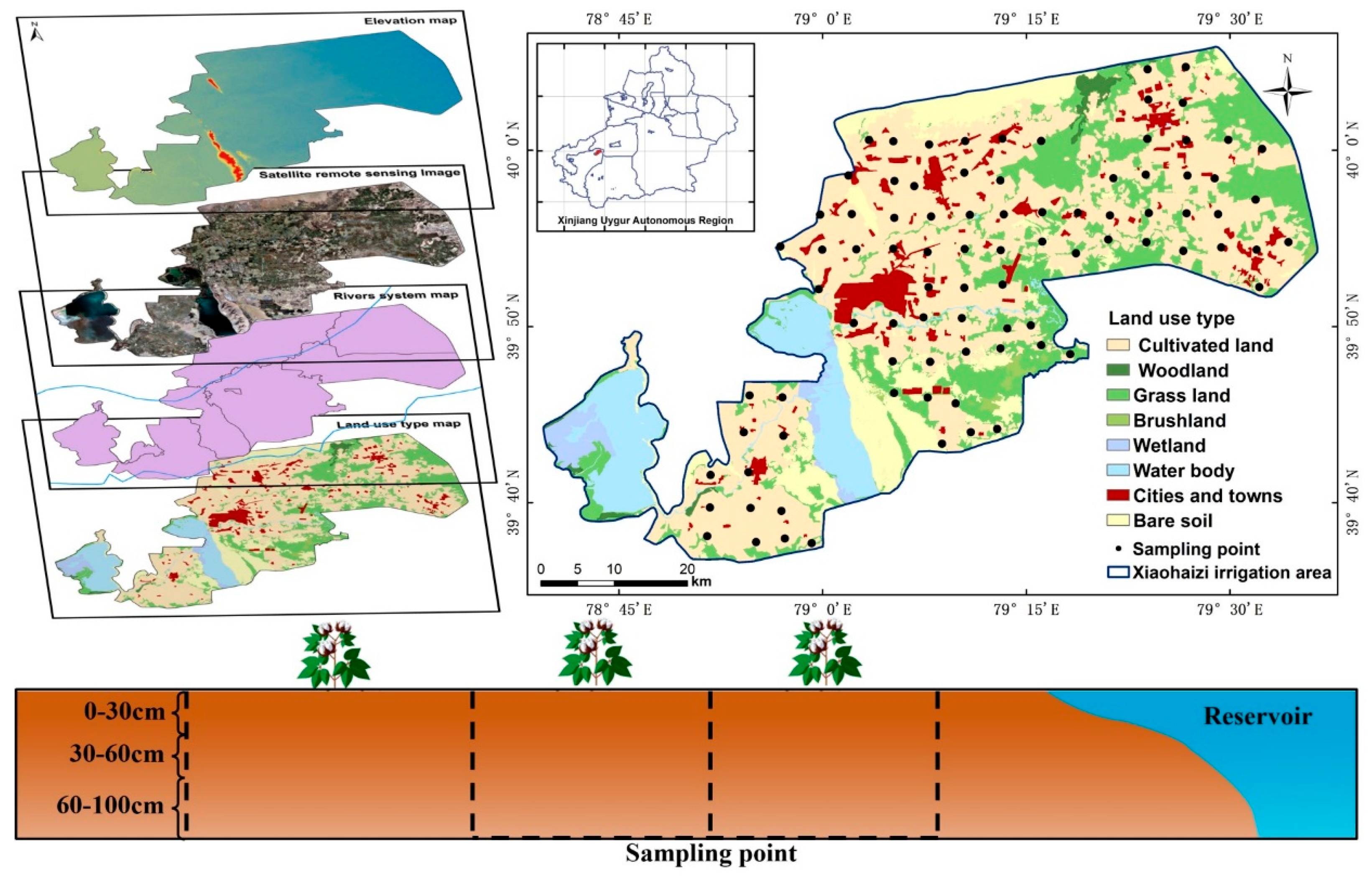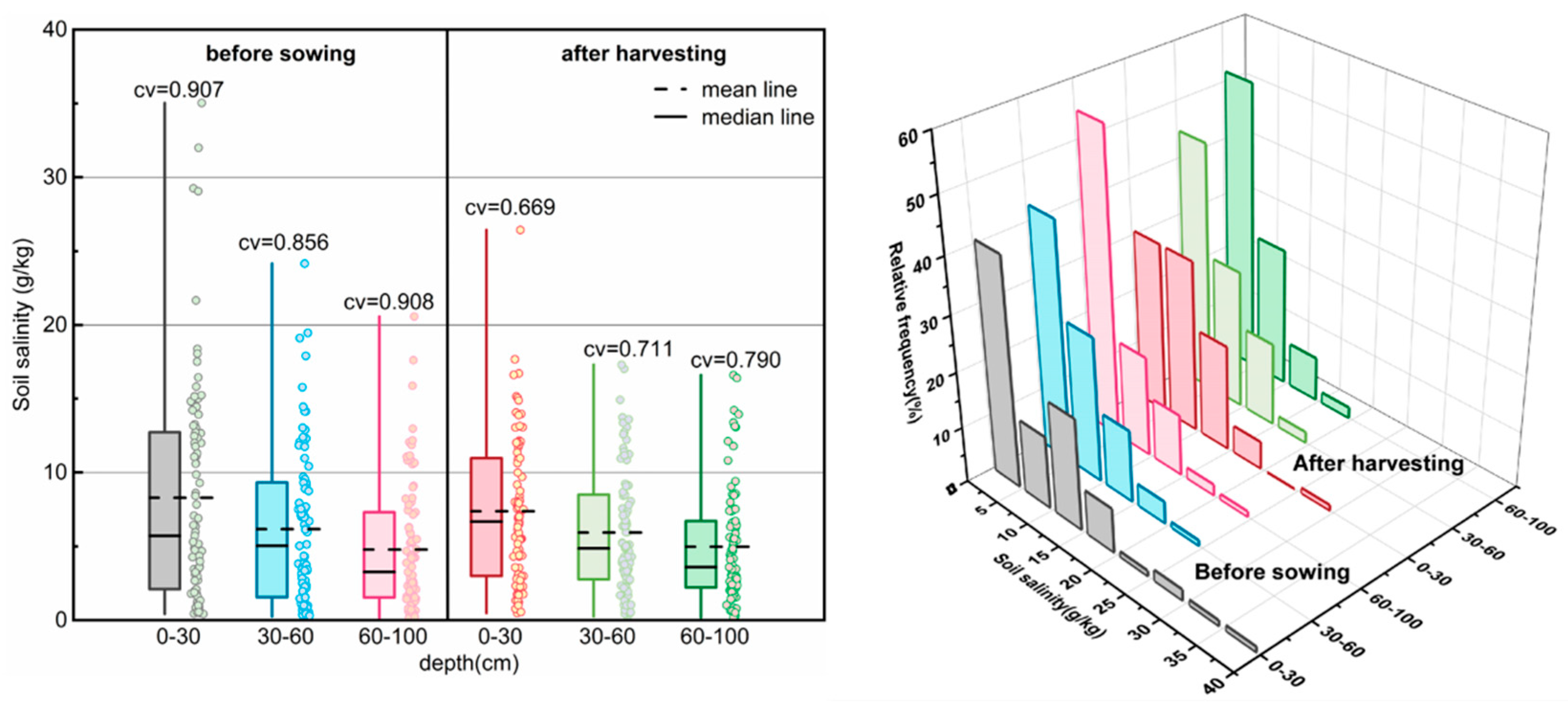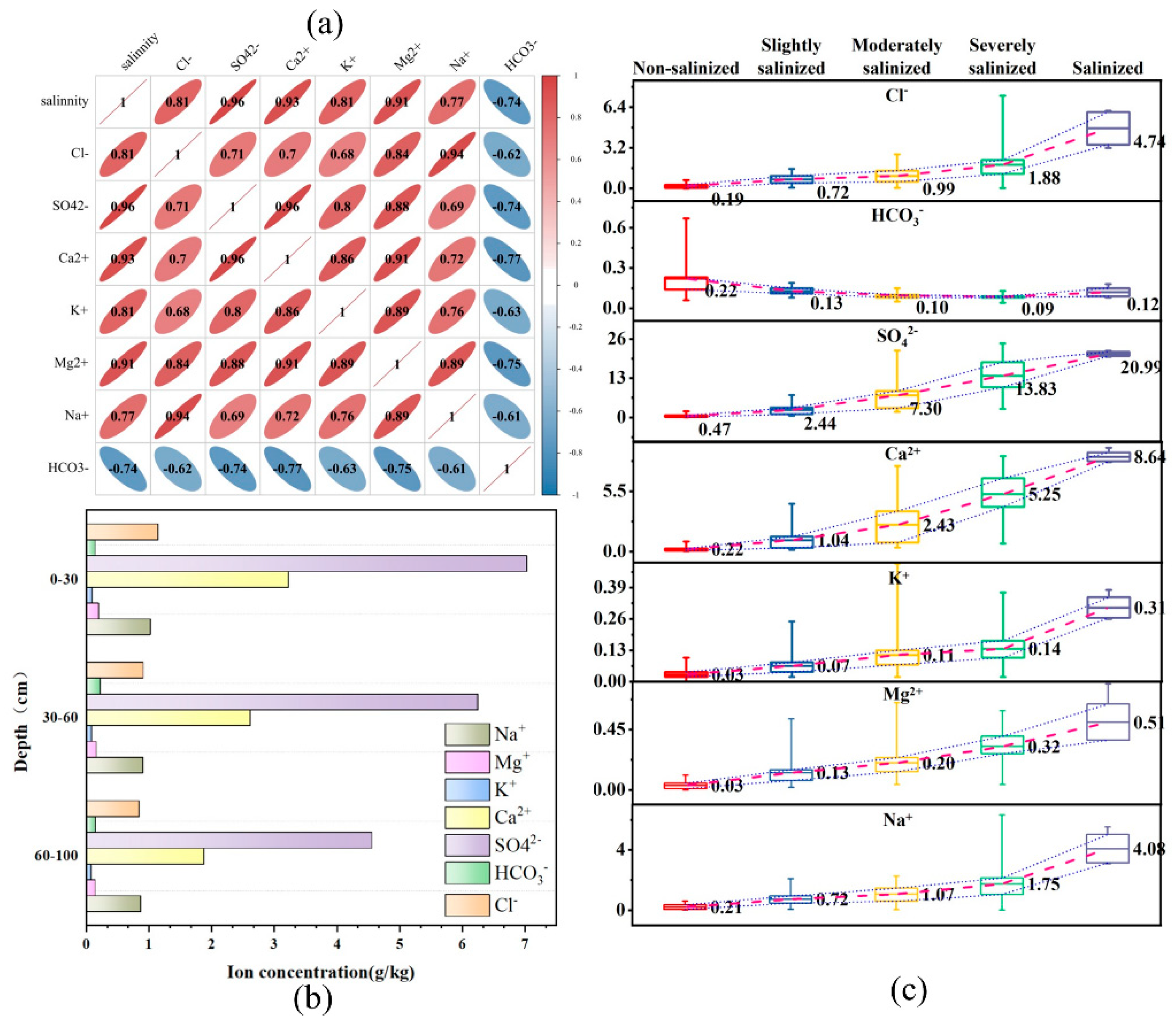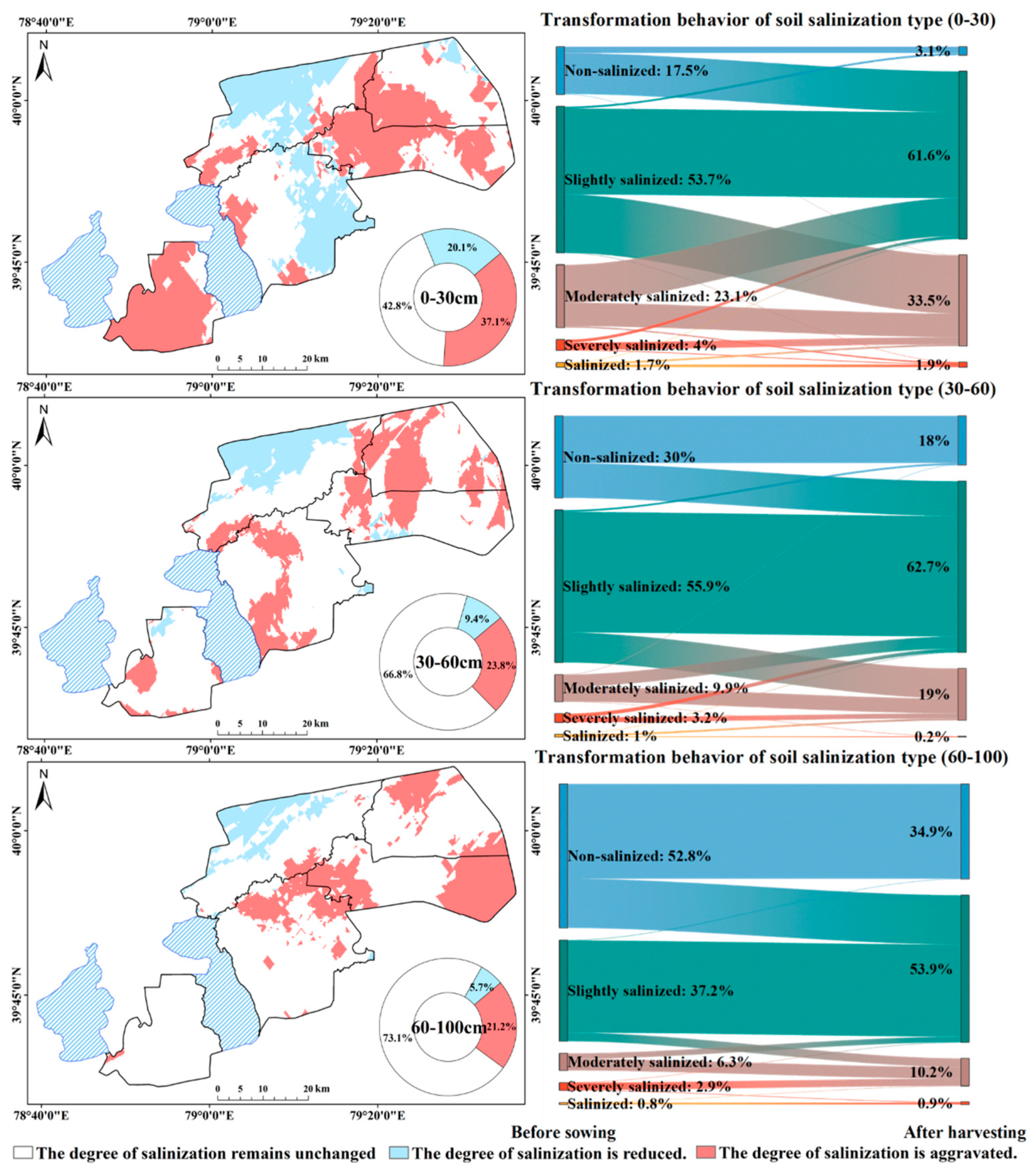Spatial Distribution and Temporal Evolution of Soil Salinization in the Oasis Irrigated Area
Abstract
1. Introduction
2. Materials and Methods
2.1. Overview of the Study Area
2.2. Data Collection
2.3. Research Methods
2.3.1. Descriptive Statistics
2.3.2. Semi-Variance Function
2.3.3. Spatial Interpolation Methods
2.3.4. Methods for Accuracy Evaluation
2.4. Data Processing
3. Results and Analysis
3.1. Descriptive Statistics of Soil Salinity
3.2. Analysis of Ion Characteristics
3.3. The Cross-Validation Analysis of Spatial Interpolation Methods
3.4. The Spatial Distribution and Temporal Evolution Characteristics of Soil Salinization
4. Discussion
4.1. Soil Salt Content in the Irrigated Area
4.2. Spatial Distribution Characteristics of Soil Salinization
4.3. Prevention Measures for Soil Salinization
5. Conclusions
- 1.
- Spatial distribution of soil salinity at different depths before sowing and after harvest.The surface layer (0–30 cm) exhibited the highest salinity, showing a pronounced surface accumulation phenomenon. Overall, salinity displayed a spatial pattern of “higher in the northwest, lower in the south.”
- 2.
- Temporal evolution of salinization, after harvest, the overall degree of salinization in the irrigation district intensified, particularly in the 0–30 cm layer, where 37.1% of the area experienced increased salinity. This highlights the significant influence of irrigation activities on the redistribution of surface salts.
- 3.
- Key ions driving salinization and their vertical distribution, SO42−, Ca2+, Mg2+, Cl−, Na+, and K+ were identified as the dominant ions contributing to salinization in the area. Among them, SO42− and Ca2+ showed a highly significant positive correlation with total salinity. Ion concentrations generally decreased with increasing soil depth.
- 4.
- Differential impacts of human activities across soil layers:Agricultural practices such as irrigation exerted a much stronger influence on surface soil salinity than on deeper layers. In the central and eastern regions, the transformation from non-saline soils to mildly or moderately saline soils was particularly pronounced.
Author Contributions
Funding
Data Availability Statement
Acknowledgments
Conflicts of Interest
References
- Kopittke, P.M.; Minasny, B.; Pendall, E.; Rumpel, C.; McKenna, B.A. Healthy soil for healthy humans and a healthy planet. Crit. Rev. Environ. Sci. Technol. 2024, 54, 210–221. [Google Scholar] [CrossRef]
- Jiang, Q.; Peng, J.; Biswas, A.; Hu, J.; Zhao, R.; He, K.; Shi, Z. Characterizing dryland salinity in three dimensions. Sci. Total Environ. 2019, 682, 190–199. [Google Scholar] [CrossRef]
- Corwin, D.L. Climate change impacts on soil salinity in agricultural areas. Eur. J. Soil Sci. 2021, 72, 842–862. [Google Scholar] [CrossRef]
- Jung, E.; Park, N.; Park, J. Composite modeling for evaluation of groundwater and soil salinization on the multiple reclaimed land due to sea-level rise. Transp. Porous Media 2021, 136, 271–293. [Google Scholar] [CrossRef]
- Srivastava, R.; Yetgin, A.; Srivastava, S. The role of legume roots in carbon sequestration, soil health enhancement, and salinity mitigation under climate change: A comprehensive review. Soil Tillage Res. 2025, 253, 106656. [Google Scholar] [CrossRef]
- Yang, S.; Miao, Q.; Shi, H.; Zhao, Y.; Liu, X.; Nie, X.; Feng, W.; Gonçalves, J.M.; Zhang, T.; Li, Y.; et al. Spatial and temporal heterogeneity of soil salinity and ionic coupling relationship under the water-saving renovation of a typical irrigation district in arid and semi-arid areas. Sci. Total Environ. 2024, 951, 175776. [Google Scholar] [CrossRef]
- Kumar, P.; Tiwari, P.; Biswas, A.; Srivastava, P.K. Spatio-temporal assessment of soil salinization utilizing remote sensing derivatives, and prediction modeling: Implications for sustainable development. Geosci. Front. 2024, 15, 101881. [Google Scholar] [CrossRef]
- Singh, A. Soil salinization management for sustainable development: A review. J. Environ. Manag. 2021, 277, 111383. [Google Scholar] [CrossRef] [PubMed]
- Tao, W.; Deng, M.; Wang, Q.; Su, L.; Ma, C.; Ning, S. Ecological agriculture connotation and pathway of high-quality agricultural development system in northwest arid region. Trans. CSAE 2023, 39, 221–232. (In Chinese) [Google Scholar]
- Hou, X.; Xiang, Y.; Fan, J.; Zhang, F.; Hu, W.; Yan, F.; Xiao, C.; Li, Y.; Cheng, H.; Li, Z. Spatial distribution and variability of soil salinity in film-mulched cotton fields under various drip irrigation regimes in southern Xinjiang of China. Soil Tillage Res. 2022, 223, 105470. [Google Scholar] [CrossRef]
- Liu, H.-Y.; Zhou, B.-H.; Yang, H.-L.; Liu, X.; Hou, Z. Dynamic characteristics of soil water and salt in cotton field of “dry sowing and wet seedling” in Xiaohaizi irrigation district. J. Shihezi Univ. (Nat. Sci.) 2024, 42, 560–568. [Google Scholar]
- Yang, J.; Zhao, J.; Zhu, G.; Wang, Y.; Ma, X.; Wang, J.; Guo, H.; Zhang, Y. Soil salinization in the oasis areas of downstream inland rivers—Case Study: Minqin oasis. Quat. Int. 2020, 537, 69–78. [Google Scholar] [CrossRef]
- Delbari, M.; Afrasiab, P.; Gharabaghi, B.; Amiri, M.; Salehian, A. Spatial variability analysis and mapping of soil physical and chemical attributes in a salt-affected soil. Arab. J. Geosci. 2019, 12, 68. [Google Scholar] [CrossRef]
- Jiang, P. Soil Improvement and Fertilization; Xinjiang People’s Publishing House: Urumqi, China, 2012; pp. 121–148. [Google Scholar]
- Terefe, R.; Yu, K.; Deng, Y.; Yao, X.; Wang, F.; Liu, J. Spatial variability of soil chemical properties of Moso bamboo forests of China. J. For. Res. 2021, 32, 2599–2608. [Google Scholar] [CrossRef]
- Kubát, J.-F.; Neumann, M.; Kavka, P. Semi-variograms provide superior spatial and temporal insights into artificial rainfall compared to Christiansen uniformity. J. Hydrol. 2025, 653, 132740. [Google Scholar] [CrossRef]
- Gao, M.; Huang, A.; Li, D.; Zhang, Z.; Wang, L.; Zhao, M. Soil Quality Evaluation in a Typical County of Jianghuai Hilly Region Based on GIS. Chin. J. Soil Sci. 2021, 52, 16–24. (In Chinese) [Google Scholar]
- Liu, Y.; Lv, T.; Song, R.; Zhang, X.; Chen, F.; Fu, X.; Li, G. Spatial Distribution of Surface Soil Moisture Content Before Spring Sowing in Typical Irrigation Areas in Southern Xinjiang. Agric. Res. Arid. Aras 2024, 42, 264–271+292. (In Chinese) [Google Scholar]
- Liao, Y.; Li, D.; Zhang, N. Comparison of interpolation models for estimating heavy metals in soils under various spatial characteristics and sampling methods. Trans. GIS 2018, 22, 409–434. [Google Scholar] [CrossRef]
- Shi, C.; Chen, L.; Zhang, Y.; He, S.; Xie, H. Study on Soil Salinization Characteristics of Cultivated Land in Xiaohaizi Irrigation Area of Xinjiang. Arid. Land Geogr. 2023, 46, 1314–1323. (In Chinese) [Google Scholar]
- Zhang, Y.; Hou, K.; Qian, H.; Gao, Y.; Fang, Y.; Xiao, S.; Tang, S.; Zhang, Q.; Qu, W.; Ren, W. Characterization of soil salinization and its driving factors in a typical irrigation area of Northwest China. Sci. Total Environ. 2022, 837, 155808. [Google Scholar] [CrossRef]
- Chi, C.; Wang, Z. Characterizing salt-affected soils of Songnen Plain using saturated paste and 1:5 soil-to-water extraction methods. Arid Land Res. Manag. 2010, 24, 1–11. [Google Scholar] [CrossRef]
- Li, W.; Wang, Z.; Zhang, J.; Zong, R. Soil salinity variations and cotton growth under long-term mulched drip irrigation in saline-alkali land of arid oasis. Irrig. Sci. 2021, 40, 103–113. [Google Scholar] [CrossRef]
- Abuduwaili, J.; Yang, T.; Abulimiti, M.; Liu, D.; Ma, L. Spatial distribution of soil moisture, salinity and organic matter in Manas River watershed, Xinjiang, China. J. Arid. Land 2012, 4, 441–449. [Google Scholar] [CrossRef]
- Li, B.; Rodell, M. Spatial variability and its scale dependency of observed and modeled soil moisture over different climate regions. Hydrol. Earth Syst. Sci. 2013, 17, 1177–1188. [Google Scholar] [CrossRef]
- Li, Y.; Zhong, B.; Xu, X.; Liang, Z. Application of a semi variogram based on a deep neural network to Ordinary Kriging interpolation of elevation data. PLoS ONE 2022, 17, e0266942. [Google Scholar]
- Tunçay, T. Comparison quality of interpolation methods to estimate spatial distribution of soil moisture content. Commun. Soil Sci. Plant Anal. 2021, 52, 353–374. [Google Scholar] [CrossRef]
- Xin, M.; Lv, T.; He, X.; Cao, Y.B.; Wang, M.M. Spatial variation of surface soil salinity in under-film drip irrigating of cotton field in irrigated areas of Manas River Basin. Agric. Res. Arid. Areas 2017, 35, 74–79. (In Chinese) [Google Scholar]
- Li, Y.; Wang, G.; Liu, Y.; Lv, N.; Liang, F.; Fan, J.; Yin, F. Distribution Characteristics of Soil Physicochemical Properties and Salt Ions in Typical Oasis Irrigation Areas of Xinjiang. Trans. Chin. Soc. Agric. Mach. 2024, 55, 357–364+414. (In Chinese) [Google Scholar]
- Li, Y.; Men, Q.; Luo, Y. Effect of fruit on water use efficiency of apple trees under soil drought. Agric. Res. Arid. Areas 2000, 80–85+90. (In Chinese) [Google Scholar]
- Yang, P.; Ding, G. Distribution characteristics and genesis analysis of groundwater salinity in Tumushuke City, Xinjiang. Ground Water 2017, 39, 252–254. (In Chinese) [Google Scholar]
- Wang, Z.; Fan, B.; Guo, L. Soil salinization after long-term mulched drip irrigation poses a potential risk to agricultural sustainability. Eur. J. Soil Sci. 2019, 70, 20–24. [Google Scholar] [CrossRef]
- Devkota, K.P.; Devkota, M.; Rezaei, M.; Oosterbaan, R. Managing salinity for sustainable agricultural production in salt-affected soils of irrigated drylands. Agric. Syst. 2022, 198, 103390. [Google Scholar] [CrossRef]
- Kramer, I.; Mau, Y. Review: Modeling the Effects of Salinity and Sodicity in Agricultural Systems. Water Resour. Res. 2023, 59, e2023WR034750. [Google Scholar] [CrossRef]
- Du, Y.; Liu, X.; Zhang, L.; Zhou, W. Drip irrigation in agricultural saline-alkali land controls soil salinity and improves crop yield: Evidence from a global meta-analysis. Sci. Total Environ. 2023, 880, 163226. [Google Scholar] [CrossRef] [PubMed]




| Salinization Type | Non Salinized | Slightly Salinized | Moderately Salinized | Severely Salinized | Salinized |
|---|---|---|---|---|---|
| saltness (g/kg) | <3 | 3~6 | 6~10 | 10~20 | >20 |
| Sample Time | Depth (cm) | Theoretical Model | Nugget C0 | Total Sill C0 + C | C0/(C0 + C) (%) | Range (m) | R2 |
|---|---|---|---|---|---|---|---|
| Before sowing | 0–30 | Gaussian | 0.83 | 29.58 | 2.8 | 5200.81 | 0.846 |
| 30–60 | Exponential | 6.87 | 28.63 | 24 | 14,820 | 0.715 | |
| 60–100 | Exponential | 2.99 | 19.99 | 15 | 17,670 | 0.934 | |
| After harvesting | 0–30 | Exponential | 13.63 | 25.26 | 50 | 7650 | 0.730 |
| 30–60 | Gaussian | 7.13 | 18.11 | 39.4 | 5300 | 0.806 | |
| 60–100 | Gaussian | 5.03 | 14.96 | 33.6 | 5455.96 | 0.829 |
| Sample Time | Depth | Prediction Error | ||||
|---|---|---|---|---|---|---|
| ME | RMSE | ASE | MSE | RMSSE | ||
| Before sowing | 0–30 | −0.0903 | 7.0298 | 7.0884 | −0.0127 | 0.9901 |
| 30–60 | −0.0703 | 4.9383 | 5.0338 | −0.0131 | 0.9821 | |
| 60–100 | −0.0164 | 3.6327 | 3.8101 | −0.0025 | 0.9578 | |
| After harvesting | 0–30 | 0.0329 | 4.8826 | 4.7632 | 0.0069 | 1.0183 |
| 30–60 | −0.0612 | 3.9856 | 4.2306 | −0.0115 | 0.9433 | |
| 60–100 | 0.0185 | 3.6572 | 3.6935 | 0.0051 | 0.9905 | |
| Irrigated Area | Annual Average Temperature (℃) | Annual Evaporation (mm) | Annual Precipitation (mm) | Steam Reduction Ratio |
|---|---|---|---|---|
| Yinchuan Plain Irrigation Area | 9.01 | 2015.63 | 187.72 | 10.74 |
| Manasi River Irrigation Area | 6.54 | 2096.6 | 124 | 16.9 |
| Xiaohaizi Irrigation Area | 11.4 | 2423.1 | 52.4 | 46.24 |
| Kashgar River Irrigation Area | 12.2 | 2459.36 | 50.72 | 48.49 |
Disclaimer/Publisher’s Note: The statements, opinions and data contained in all publications are solely those of the individual author(s) and contributor(s) and not of MDPI and/or the editor(s). MDPI and/or the editor(s) disclaim responsibility for any injury to people or property resulting from any ideas, methods, instructions or products referred to in the content. |
© 2025 by the authors. Licensee MDPI, Basel, Switzerland. This article is an open access article distributed under the terms and conditions of the Creative Commons Attribution (CC BY) license (https://creativecommons.org/licenses/by/4.0/).
Share and Cite
Lv, T.; Liu, Y.; Bian, M.; Zhang, X.; Chen, C.; Wang, M. Spatial Distribution and Temporal Evolution of Soil Salinization in the Oasis Irrigated Area. Agronomy 2025, 15, 2413. https://doi.org/10.3390/agronomy15102413
Lv T, Liu Y, Bian M, Zhang X, Chen C, Wang M. Spatial Distribution and Temporal Evolution of Soil Salinization in the Oasis Irrigated Area. Agronomy. 2025; 15(10):2413. https://doi.org/10.3390/agronomy15102413
Chicago/Turabian StyleLv, Tingbo, Yifan Liu, Menghan Bian, Xiaoying Zhang, Conghao Chen, and Maoyuan Wang. 2025. "Spatial Distribution and Temporal Evolution of Soil Salinization in the Oasis Irrigated Area" Agronomy 15, no. 10: 2413. https://doi.org/10.3390/agronomy15102413
APA StyleLv, T., Liu, Y., Bian, M., Zhang, X., Chen, C., & Wang, M. (2025). Spatial Distribution and Temporal Evolution of Soil Salinization in the Oasis Irrigated Area. Agronomy, 15(10), 2413. https://doi.org/10.3390/agronomy15102413




